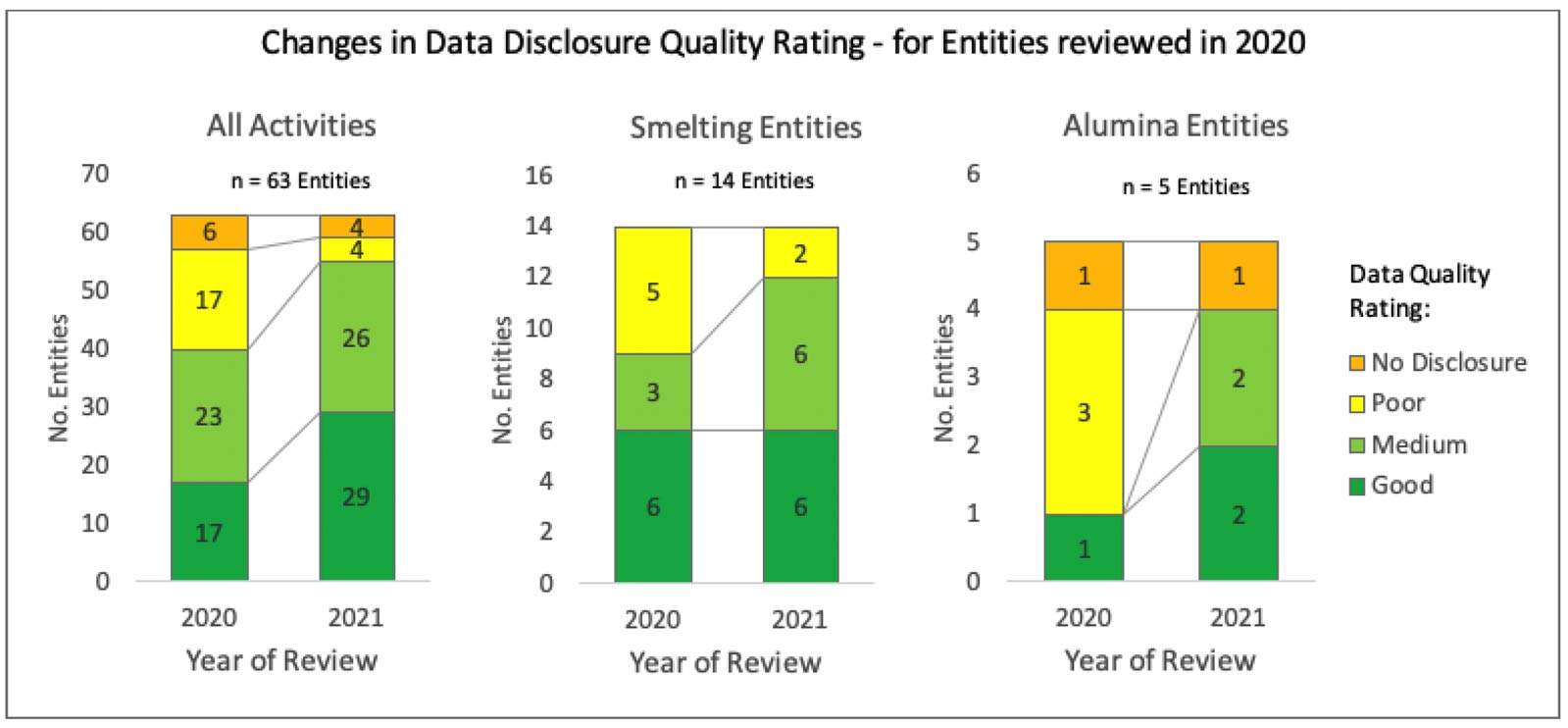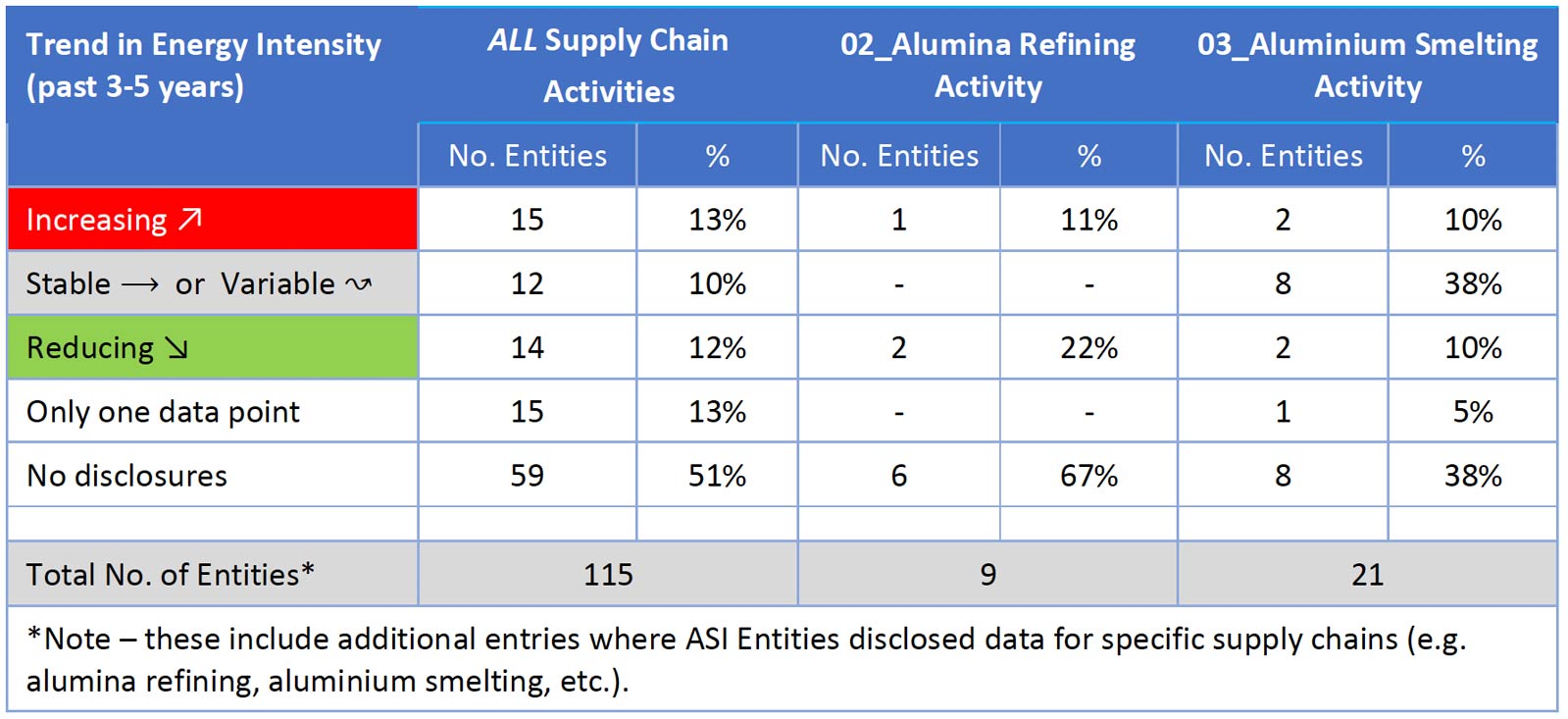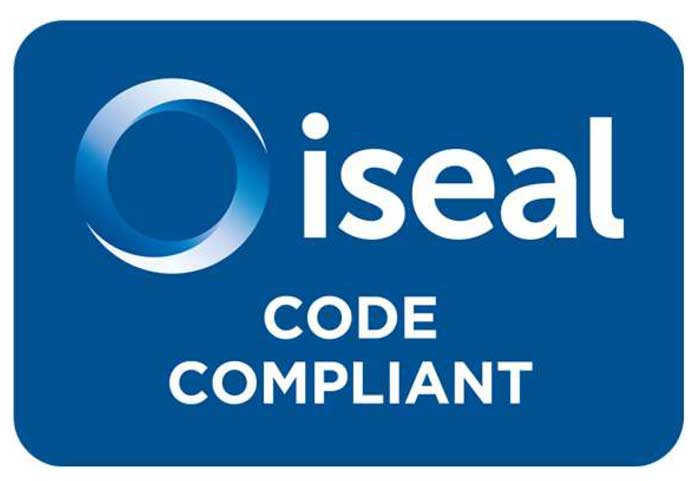Analysis of 2020-2021 GHG Emissions disclosures by ASI Certified Entities reveals data quality improvement with mixed overall performance
M&E Insights, August 2021 Following an inaugural study carried out in 2020, ASI has today published a report which analyses greenhouse gas (GHG) emissions and energy use data disclosures by ASI Certified Entities with certification periods covering April 2020 to March 2021. The study, which reveals an improvement in data quality but mixed overall performance, […]
29 August 2021
 M&E Insights, August 2021
M&E Insights, August 2021
Following an inaugural study carried out in 2020, ASI has today published a report which analyses greenhouse gas (GHG) emissions and energy use data disclosures by ASI Certified Entities with certification periods covering April 2020 to March 2021. The study, which reveals an improvement in data quality but mixed overall performance, contributes to understanding progress towards ASI’s medium-term outcome, reducing climate change impact. It was conducted by Atmolite Consulting Pty Ltd.
The findings are a snapshot of GHG and energy data disclosures available in June 2021, with granularity at the regional, country and supply chain activity level (from bauxite mining to downstream activities). New in this year’s report is a comparison of publicly disclosed data from ASI Entities against data from CRU’s Emissions Analysis Tool, for primary aluminium activities.
Key findings from the report include:
- Quality of data disclosures: The study shows that the overall level and quality of data disclosure for various ASI Entities appears to be improving compared to the 2020 review. In the 2021 assessment, 73% of certified ASI Entities provide either a comprehensive (‘good’) or reasonable (‘medium’) level of data disclosures, relating to their scope of certification; this includes 86% of aluminium smelting Entities and 55% of alumina refining Entities.
- Trends in energy intensity: Reductions in total energy intensity (GJ/t) over the previous three to five year period were observed for 12% of all Entities, 22% of Alumina Refining Entities and 10% of Smelting Entities in 2021. Of Smelting Entities where trends could be assessed, approximately 85% are either stable or trending down in energy intensity over time. However, increases in energy intensity were reported for 13% of all Entities, 11% of Alumina Refining Entities (n=1) and 10% of Smelting Entities in 2021 (n=2).
- Trends in GHG Emission Intensity (Scope 1+2): Reductions in GHG emission intensities over the previous three to five year period were observed for 16% of all Entities, 22% of Alumina Refining Entities and 19% of Smelting Entities in 2021. The majority of ASI’s Smelting Entities are either stable or trending down over time in their disclosed emissions intensity. However, increases in GHG emission intensities were observed for 6% of all Entities (n=7) and 5% of Smelting Entities in 2021 (n=1).
In total, the review covered between 100-150 Mt emissions (Scope 1 and 2), representing approximately 10% of the global aluminium sector total.
The number of Certified Entities reviewed increased by 70% since the last assessment (87 Entities in 2021 vs 51 Entities in 2020).
The 87 Certified Entities reviewed in 2021 were from 55 ASI Member companies. Some of the 87 Entities reported separate data for individual supply chain activities (for example for bauxite mining, alumina refining and aluminium smelting) and these were captured as additional data entries in the report. Therefore in total, there were 115 ‘modified Entities’, incorporating multiple supply chain activities. Of the 115 ‘modified Entities’, 21 are engaged in aluminium smelting and 9 in alumina refining.
Assessing Quality of Data Disclosures from ASI Entities
The study shows that the overall level and quality of data disclosure for various ASI Entities appears to be improving compared to the 2020 review. Some improvements have resulted from these independent reviews (2020-2021) and the feedback provided to specific Entities by the authors regarding their disclosed data. In the 2021 assessment, 73% of certified ASI Entities provide either a comprehensive (‘good’) or reasonable (‘medium’) level of data disclosures, relating to their scope of certification; this includes 86% of aluminium smelting Entities and 55% of alumina refining Entities.

Figure 1: Graph from the report comparing data disclosure quality for ASI Entities reviewed in 2020, with all activities (left), Smelting Entities (centre) and Alumina Entities (right)
Many newly certified ASI Entities are publicly disclosing their sustainability performance on their website for the first time, including in countries such as China and in smaller enterprises and/or remelting, semi-fabrication and material conversion operations. Whilst there is still room for improvement in the quality, standardisation and format of these data disclosures, ASI continues to play an important role in ensuring data disclosure (both quality and quantity) and transparency improves.
However, the authors also state that increased disclosures alone will not achieve the significant cuts in the overall carbon footprint of the global aluminium production that is required by climate science (80% absolute emissions, as per IAI ‘Beyond 2 Degree Scenario’ or ‘B2DS’ (IAI, 2021)). Disclosures must be coupled with significant changes in technology, finance, consumption patterns, product lifetimes and more across the entire aluminium value chain.
Trends in Energy Intensity from ASI Entities
Reductions in total energy intensity (GJ/t) over the previous three to five year period were observed for 12% of all Entities, 22% of Alumina Refining Entities and 10% of Smelting Entities in 2021. Of Smelting Entities where trends could be assessed, approximately 85% are either stable or trending down in energy intensity over time. However, increases in energy intensity were reported for 13% of all Entities, 11% of Alumina Refining Entities (n=1) and 10% of Smelting Entities in 2021 (n=2). This may have been impacted by greater inefficiencies if production was reduced due to impacts from the ongoing Covid-19 pandemic (e.g. energy usage to keep furnaces or reduction cells running but less metal is going produced).

Figure 2: Table from report showing the overall trend in energy intensity (2021 assessment) for all of ASI’s Entities, as well as for Alumina Refining and Aluminium Smelting activities.
Trends in GHG Emission Intensity (Scope 1+2) from ASI Entities
Reductions in GHG emission intensities over the previous three to five year period were observed for 16% of all Entities, 22% of Alumina Refining Entities and 19% of Smelting Entities in 2021. The majority of ASI’s Smelting Entities are either stable or trending down over time in their disclosed emissions intensity. However, increases in GHG emission intensities were observed for 6% of all Entities (n=7) and 5% of Smelting Entities in 2021 (n=1). This may have been impacted again by the greater inefficiencies if production was reduced due to impacts from COVID-19 (e.g. furnaces or reduction cells maintained, but less metal produced).

Figure 3: Table from the report showing the overall trend in Scope 1+2 GHG emissions intensity in the 2021 assessment for all of ASI’s Entities (all activities), as well as for Alumina Refining and Aluminium Smelting activities.
Recommendations
To further improve the quality, transparency and benchmarking of GHG data disclosures, the authors make the following recommendations:
- a) Encourage disclosures relevant to facility or activity, which allows aggregation to ASI certification scope level (not aggregated data that can include non-certified production sites or multiple processes);
- b) Encourage disclosures of not only electricity use, but total energy use and energy use per energy carrier (fuels, electricity, etc.) which is a more relevant proxy for GHG emissions and carbon footprint (particularly for non-Smelter processes);
- c) Standardise the scope and units of disclosure, both totals and intensities (per unit of production), preferably indicating the specific numerators and denominators used when intensities are reported. These could be implemented through use of standardised data reporting templates, such as those already employed by the International Aluminium Institute (IAI) and other industry associations;
- d) Finally, as per the IAI’s Beyond2 Degrees Scenario (B2DS) to 2050 (IAI, 2021), the ultimate goal is decarbonisation of the entire aluminium sector, and particularly important for the primary aluminium smelting sector. Success will require all aluminium smelters to shift down the current emissions curve, particularly those currently using carbon-intensive sources of power.
ASI Management Response
This follow-up study provides very useful insights in the energy use and GHG emissions reporting and disclosures of ASI Entities, energy use and GHG emissions comparison across ASI aluminium supply chain activities, from bauxite mining to downstream activities. ASI welcomes the findings and recommendations from the report, and will use these in the following ways:
- As with the 2020 study, the findings and recommendations from this evaluation will directly inform the ASI Standards Revision 2020-2022 and ASI Performance Standard Principle 5 – GHG Emissions. The second draft documents will go out for public consultation in Q1 2022. The report findings will also be discussed with the ASI Standards Committee and GHG Working Group.
- In addition to the recommendations from this report, ASI has proposed in the draft ASI Performance Standard V3.0 (draft 1.0 – March 2021) that publicly disclosed GHG data to be independently verified. For an overview of ASI’s Standards Revision process and new requirements for Principle 5, please refer to the ‘ASI Standards – 2021 Consultation Round I – Overview’
- ASI agrees with the authors that the current ‘2030 smelter emissions threshold’ of 8 t CO2e/t Al provides less incentive for smelters in the upper 50% of the emissions curve to consider ASI certification. To engage more smelters and provide further incentives, ASI has therefore included alternative pathways in the ASI Performance Standard V3.0 (draft 1.0 – March 2021) to certification for smelters above the current 8t CO2e/t threshold, whilst still requiring clear, significant and time-bound reductions in GHG emissions.
- This evaluation will also inform the development of GHG-specific member and auditor training modules which will be published as part of the ASI Standards Revision process. The modules aim to support the implementation and the evaluation of the revised ASI Performance Standard Principle 5 Criteria, and will help Entities point to relevant tools and resources for GHG accounting and reporting.
- The comparison of publicly disclosed data from ASI Entities against data from CRU’s Emissions Analysis Tool, for primary aluminium activities, provides for the valuable checking of data and is a tangible outcome of ASI’s recent MoU with CRU. Over the coming months, ASI Certified Entities’ CoC certification status, inclusion of rolling mills and the challenges of differing GHG inventory scopes will be added to the CRU Emissions Analysis Tool.
- In conjunction with the CRU Emissions Analysis Tool, the ASI Secretariat will also use the analysis contained in this report to inform oversight of audit reports for GHG disclosures. The study provides a ‘year on year’ snapshot of Certified Entity data being publicly disclosed, enables comparison between similar Entity types. In addition, the CRU Emissions Analysis Tool enables the Secretariat to compare the Entity’s publicly disclosed data against the best available emissions intensity estimate published in the CRU Tool. Upon identification of any material discrepancy, the ASI Secretariat will liaise with the auditors and/or Entity to address any errors or inaccuracies in the public data.
Stay tuned for our next M&E Insights article coming in the September newsletter!
SHARE THIS ARTICLE


